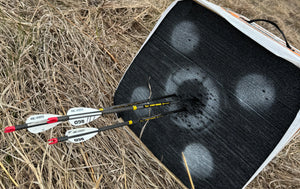Arrow spine refers to the stiffness of an arrow shaft. It's a crucial factor in achieving accurate and consistent shots with your compound bow. Here's a breakdown of arrow spine and its impact on your archery:
Understanding Spine:
- Imagine an arrow as a long, thin spring. Arrow spine is a measure of how much that spring bends or flexes under pressure. A stiffer arrow (lower spine rating) will bend less, while a weaker arrow (higher spine rating) will bend more.
Spine Rating System:
- Arrow spine is typically denoted by a number. Higher spine numbers indicate weaker or more flexible arrows, while lower numbers indicate stiffer arrows. Generally speaking stiffer spines would typically be rated at 350 or lower, and more flexible spines would be greater than 350. Compound bows with shorter draw lengths and/or less poundage will correspondingly shoot more flexible arrows and vice-versa.
It's important to note that there's no universal spine rating system across all arrow manufacturers. Always refer to the specific manufacturer's chart for their spine ratings and recommendations.
Matching Spine to Setup:
- The ideal arrow spine depends on several factors, including:
- Draw Weight: Higher draw weights require stiffer arrows to handle the increased pulling force without excessive flexing.
- Arrow Length: Longer arrows generally require stiffer spines to maintain stability in flight.
- Point Weight: Heavier broadheads or field points necessitate stiffer arrows to compensate for the additional weight at the front.
The Importance of Spine:
- Using an arrow with an improper spine can significantly affect your shot in two ways:
- Under-spined Arrow: An arrow that's too weak will flex excessively in flight. This can cause erratic arrow flight, resulting in unpredictable groupings that veer to the right.
- Over-spined Arrow: A stiffer arrow than necessary can also be detrimental. It may not flex enough to properly correct itself during flight, leading to leftward grouping tendencies.
Spine Tuning:
- Finding the optimal arrow spine for your bow setup is called spine tuning. There are various methods for spine tuning, some involving shooting bares hafts (arrows without fletching) and observing their flight path. It's recommended to consult an archery shop or experienced archer to assist with spine tuning for best results.
Here's how to determine your proper arrow spine selection:
1. Gather Information:
- Draw Weight: This is the pulling force required to fully draw your bow. You'll find this specification stamped on your bow or in the owner's manual.
- Arrow Length: Measure the actual length of your arrow shaft from nock (where the string attaches) to the end of the insert (the small piece that holds the field point or broadhead).
- Point Weight: Weigh your field points or broadheads (without the insert) to determine their individual weight.
2. Consult Manufacturer's Charts:
- Visit the website of your preferred arrow manufacturer. They'll have a spine selection chart that considers factors like draw weight, arrow length, and point weight.
- Locate the chart specific to your chosen arrow model.
- Find the intersection point on the chart that corresponds to your draw weight and arrow length. This will provide a recommended spine range.
3. Consider Additional Factors:
- Broadhead vs. Field Points: If you plan to use broadheads for hunting, choose a slightly stiffer spine within the recommended range compared to field points. Broadheads are typically heavier and require a more robust arrow to maintain stability in flight.
- Shooting Style: Some archers prefer a slightly stiffer arrow for a flatter trajectory, especially for longer distances. If you're unsure, opting for the stiffer side within the recommended range is a safer bet for most situations.
4. Consult a Professional (Optional):
- Archery shops often have experienced staff who can assist with arrow selection. They might consider factors like your shooting style and desired performance to recommend a specific spine within the appropriate range.
- If you're a beginner or have doubts, seeking guidance from a professional archer or archery shop can be beneficial.
5. Spine Tuning (Optional but Recommended):
- While the manufacturer's chart provides a good starting point, fine-tuning the spine selection can further optimize accuracy. This process, called spine tuning, involves shooting bareshafts (arrows without fletching) and observing their flight path.
- Due to the complexity of spine tuning, it's recommended to consult an archery shop or experienced archer who can guide you through the process and interpret the bareshaft flight patterns.
Remember: The goal is to find an arrow spine that provides consistent and accurate flight. Using the manufacturer's chart as a foundation and considering the additional factors will get you close. Fine-tuning with bareshaft testing can further optimize your arrow selection for peak performance.

